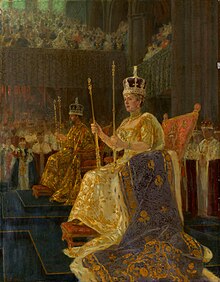A royal consort is the spouse of a reigning monarch. Consorts of British monarchs have no constitutional status or power but many have had significant influence, and support the sovereign in his or her duties.[1] There have been 11 royal consorts since Britain's union of the crowns in 1707, eight women and three men.
Prince Philip, the husband of Queen Elizabeth II, is the longest-serving and oldest-ever consort, and served for nearly 70 years until his death in 2021. Since the accession of Charles III on 8 September 2022, his wife Camilla has held the position of queen consort.[2]
Since the union of England and Scotland in 1707, there have been eleven consorts of the British monarch.[3] Queens between 1727 and 1814 were also Electress of Hanover, as their husbands all held the title of Elector of Hanover.[4] Between 1814 and 1837, queens held the title as Queen of Hanover, as their husbands were kings of Hanover.[5] The personal union with the United Kingdom ended in 1837 on the accession of Queen Victoria because the succession laws (Salic Law) in Hanover prevented a female inheriting the title if there was any surviving male heir (in the United Kingdom, a male took precedence over only his own sisters, until the Succession to the Crown Act 2013 which removed male primogeniture).[6] In the Austro-Prussian War of 1866, Hanover was annexed by Prussia and became the Province of Hanover.[7]
Not all wives of monarchs have become consorts, as they may have died, been divorced before their husbands' acceding to the throne, or married after abdication. Such cases include Princess Sophia Dorothea of Celle, wife of George, Hereditary Prince of Brunswick-Lüneburg (later King George I); Wallis Warfield, wife of Prince Edward, Duke of Windsor (the former King Edward VIII); and Lady Diana Spencer, wife of Charles, Prince of Wales (later King Charles III).
Only George I and Edward VIII were unmarried throughout their reigns.[8]
Since 1937, the sovereign's consort and the first four individuals in the line of succession who are over 21 may be appointed counsellors of state. Counsellors of state perform some of the sovereign's duties in the United Kingdom while the sovereign is out of the country or temporarily incapacitated.[9]
The wife of the reigning king as his consort is styled as "Her Majesty The Queen" during her husband's reign and "Her Majesty Queen [first name]" upon her husband's death. The Queen is referred to as "Her Majesty" and addressed as "Your Majesty". Since her coronation in 2023, the current royal consort, Queen Camilla, has also been styled as "Her Majesty The Queen" per tradition. Camilla was styled as "Her Majesty The Queen Consort" preceding the coronation to distinguish her from her then recently deceased mother-in-law, Queen Elizabeth II, who as a queen regnant was also styled as "Her Majesty The Queen".[10][11]

The husband of a reigning queen does not share the regal title and style of his wife, and the three men who served as consort held various titles. The title of “Prince Consort” has only been held by Queen Victoria's husband Prince Albert

Queens consort participate in the coronation ceremony, undertaking many of the same ceremonies as the monarch. Queens traditionally wear elaborate robes and walk in the procession under a canopy. They have also been anointed with holy oil and been crowned. Traditionally, male consorts are not crowned or anointed during the coronation ceremony.[12]
An unusual case was Caroline of Brunswick-Wolfenbüttel, who had separated from her husband, George IV, before his accession, became queen consort by law but had no position at court and was forcibly barred from attending his coronation and being crowned.[13]
The earliest surviving consort's crown is that created in 1685 for Mary of Modena. In the early-20th century, new crowns were created for each queen consort in turn. However, Queen Camilla did not have a new crown created for her coronation in 2023 and she was crowned using the 1911 Crown of Queen Mary.[14]
The Queen Consort's Ring was first created for the coronation of Queen Adelaide in 1831, and has been used by queens consort ever since.[14]
The Queen Consort's Rod with Dove represents 'equity and mercy' and the dove, with its folded wings, is symbolic of the Holy Ghost. The Queen Consort's Sceptre with Cross, originally made for the coronation of Mary of Modena in 1685, is inlaid with rock crystals.[14]
